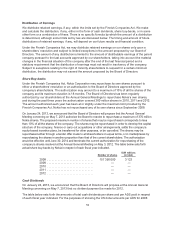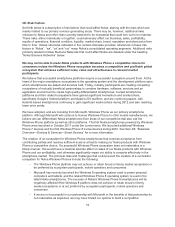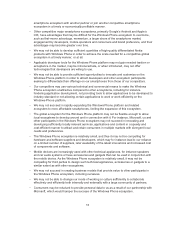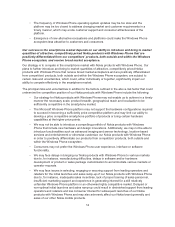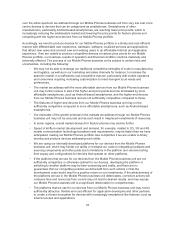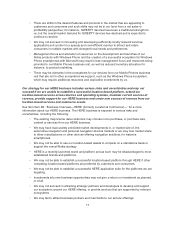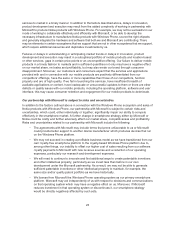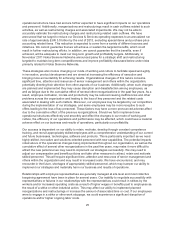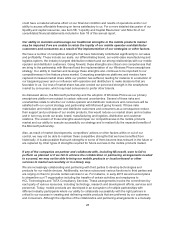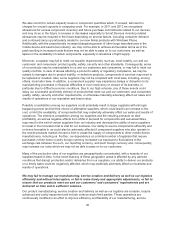Nokia 2012 Annual Report Download - page 21
Download and view the complete annual report
Please find page 21 of the 2012 Nokia annual report below. You can navigate through the pages in the report by either clicking on the pages listed below, or by using the keyword search tool below to find specific information within the annual report.The availability and success of Google’s Android platform has made entry and expansion in the
smartphone market easier for a number of hardware manufacturers which have chosen to join the
Android ecosystem, especially at the mid-to-low range of the smartphone market. Additionally, this is
increasingly reducing the addressable market and lowering the price points for Nokia feature phones.
Product differentiation is more challenging, however, potentially leading to increased commoditization
of Android-based devices with the resulting downward pressure on pricing.
The significant momentum and market share gains of the global ecosystems around the Android
platform, where Samsung is the dominant participant, and Apple’s iOS platform have increased the
competitive barriers to additional entrants looking to build a competing global smartphone ecosystem.
In 2012, driven by successful product launches, the value market share of Android-based and Apple
products continued to increase, with Samsung and Apple together capturing the majority of the profits
in the smartphone market in 2012. These two entrenched ecosystems also captured the vast majority
of smartphone applications and services by easily attracting third-party software developers to their
ecosystems and, as a result, realized much of the industry profits made on applications and services.
The dominance of the Android and Apple ecosystems makes the growth of other ecosystems, such as
the Windows Phone ecosystem, increasingly more difficult. At the same time, other ecosystems are
being built which are attracting developers and consumers, and may result in fragmentation among
ecosystem participants and the inability of new ecosystems to gain sufficient competitive scale.
During the transition of our smartphones to the Windows Phone platform, our competitors have and, as
we target to grow this ecosystem, will continue to endeavor to attract our current and future
consumers, mobile operators and other customers to their smartphone offerings. Our competitors use
aggressive business strategies in attracting and retaining customers while dissuading their switching to
other products. If our competitors succeed in that endeavor, our smartphone market share could erode
further, which we may not be able to regain with new Nokia products with Windows Phone.
In the feature phone market, an increasing number of our competitors, particularly recent entrants,
have used, and we expect will continue to use, more aggressive pricing and marketing strategies,
different design approaches and alternative technologies that consumers may prefer over our offering
of feature phones. For example, certain industry participants bundle mobile device deals with their
networks’ deals. Some competitors, with lower profitability expectations, have chosen to focus on
building feature phones based on commercially available components, software and content, in some
cases available at very low or no cost, which enables them to introduce their products much faster and
at significantly lower cost to the consumer than we are able to do. Smartphones of other manufactures,
particularly Android-based smartphones, are reaching lower price points which is increasingly reducing
the addressable market and lowering the price points for feature phones and may adversely affect our
feature phone business. We have devices with features such as full touch that can be categorized as
smartphones in our Mobile Phones business unit which face competition from other smartphone-like
and smartphone devices such as Android-based devices.
We are also seeing the emergence of various local mobile device manufacturers that are strong in a
certain country or region, especially in emerging markets. Success of such competitors could adversely
affect sales of our mobile devices in various countries such as China, Indonesia and India where we
have been traditionally strong.
We also face competition from vendors of legitimate, as well as unlicensed and counterfeit, products
with manufacturing facilities primarily centered around certain locations in Asia and other emerging
markets. The entry barriers for these vendors are very low as they are able to take advantage of
licensed and unlicensed commercially available free or low-cost components, software and content.
Our failure to provide low-cost differentiated alternatives for consumers in a timely manner or to
enforce our intellectual property rights adversely affects our ability to compete efficiently in the market
20


